Getting to know the John 3:15 Guest House and its immediate surround
After sleeping rather heavily and also doing a fair amount of sweating, even in the air conditioned room… I awoke and began to explore my base of operations for the week ahead – the guest house:

The walled-in nature of the property renders it more of a compound, one which is surprisingly (and to my thinking, delightfully!) self-sufficient. The city power grid, as mentioned in the preceding post here, is terribly unreliable – and so the compound features the below diesel backup generator (and behind it is a well, while in front of it is a water tank)…
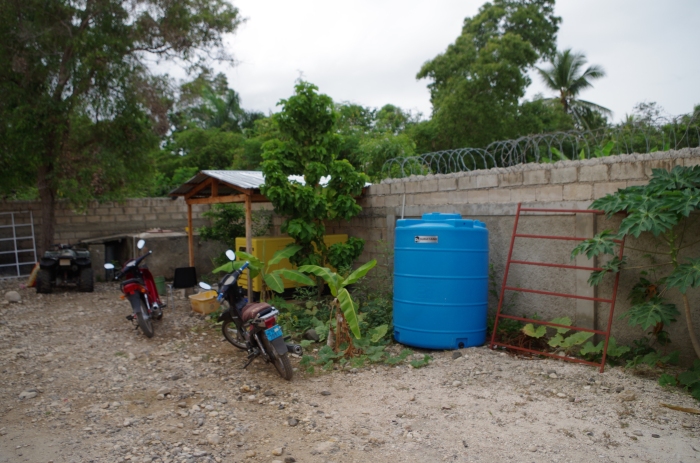
… and while I never got up on the roof to get photos, the guest house also features solar panels and a large series of car batteries, so it will at the very least have lights and electric fans 24/7 (the bedrooms’ AC uses more power than the current solar array can provide). The exterior of the house is very neat and clean, but pales in comparison to the gorgeous interior of the building, with its fun use of bright colors and my personal favorite – wooden paneled ceiling tiles:
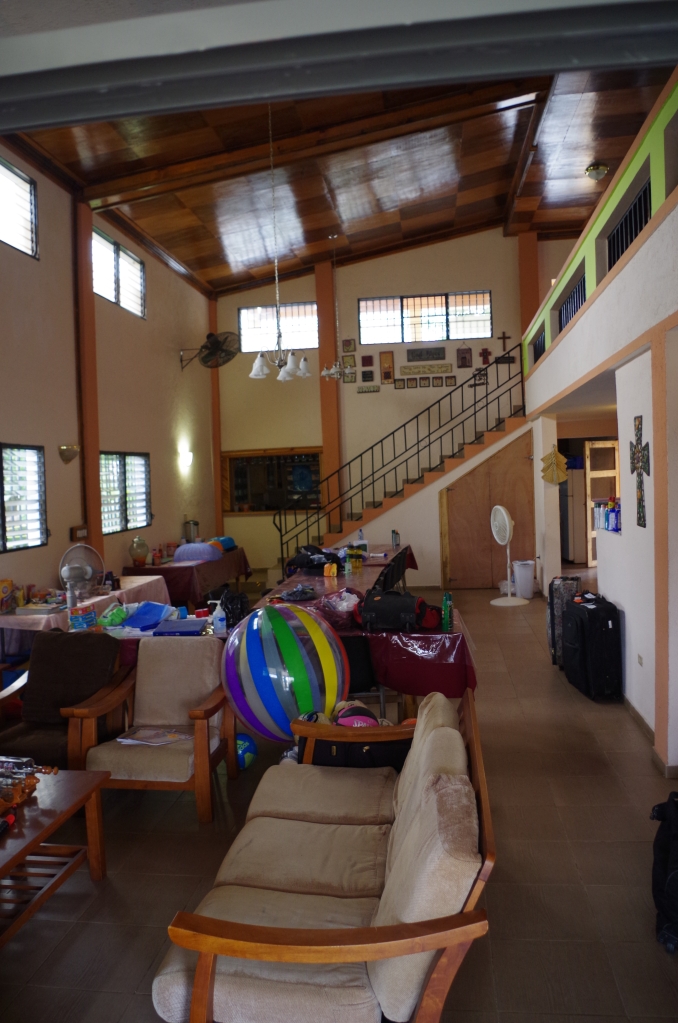
Walking upstairs from the dining/living room area on the first floor you will find the two main bedrooms and associated bathrooms, all of which can get PRETTY warm on even a nice day (as I mentioned in the first post, concrete architecture doesn’t lend itself to weeping heat or humidity):


The kitchen features some new appliances but the core cooking implement used is very forward-thinking for a Haitian kitchen – a propane stove (off to the right in the below picture, not visible unfortunately) rather than a charcoal grill as is the national tendency. More efficient, cooks faster, burns cleaner, it is the hope of our teams and our local partners to help encourage the expansion of propane use for cooking over time!
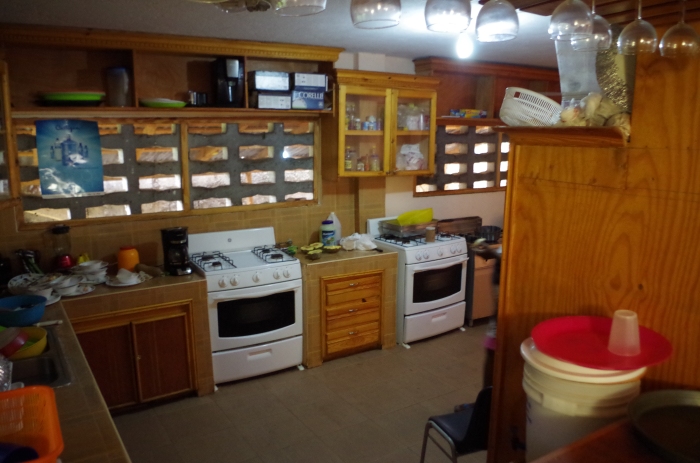
The bedrooms are eerily reminiscent of those I encountered in Zambia back in 2008 (featuring some mosquito netting, bunk beds, and the camaraderie born of close quarters and shared sweat), and were yet another bit of evidence in my life that “electric fans are one of the best things ever invented”:

The view from our back porch was of one of Haiti’s gorgeous mountains and then a mixture of some sort of feeding program warehouse (mid distance in the frame); agricultural fields (foreground of frame); and humidity (all of frame):

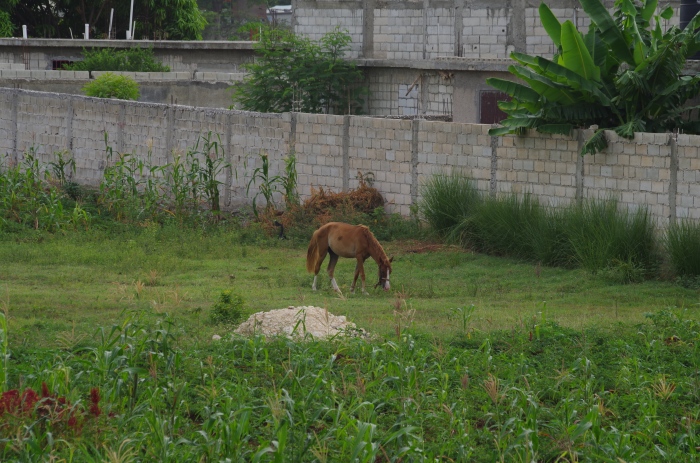
Stepping outside the large rolling gate of the compound and turning left towards the main road on which we drove into town, one gets a quick sense of the uniformity of concrete as building material; the roughness of many roads off the main road; and the creeping desertification of the island in the absence of sufficient tree cover:

Walls are always topped with the cheaper option (broken glass bottles and shards into dried cement) or the more expensive option (razor wire) for added protection… but sometimes, our walls can’t keep everyone out of the compound:
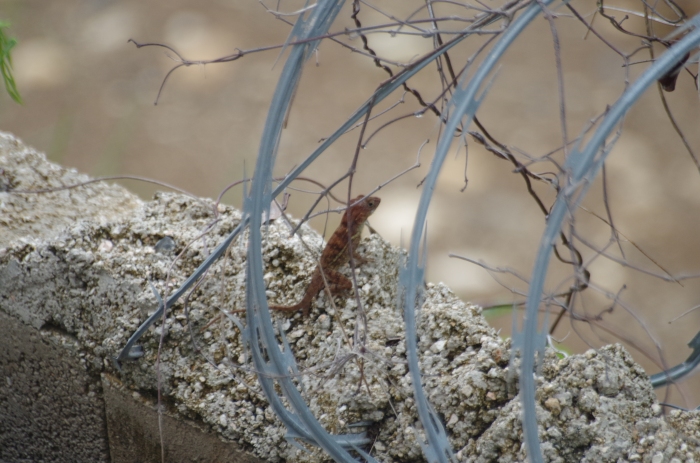
Pausing from the current week of work to consider potential future projects: a vocational and technical school
One of the first tasks of the day was to jump onto the back of a dirtbike driven by my brother to go down the road to an unfinished building site to get the following photos. There is the future possibility that we will try and create a vocational school teaching something between 9 and 12 different trades on this very site (the abandoned foundation of the replacement church building – the original church was destroyed in the earthquake, and this site was abandoned in favor of moving closer to the main road to attract more visitors). Haiti has something like an 80% unemployment rate (which is INSANE), and this is exacerbated greatly because the easiest and most important subsistence jobs (farming, and to a lesser degree, gardening) are looked down upon as being the lowest of the low (Haiti doesn’t have a caste system, but if they did, farmers would be something like the Untouchables of India). This is so sad to me, as the environment here is perfectly suited to grow many sorts of foods very easily – but our job is not to change the culture as outsiders, but instead to work with local people to help them decide how they’d like to proceed in bettering themselves and their neighbors.

Therefore, given that this building is partially done, and that offering a variety of skillsets will enable the graduating students of this eventual school will go on to hopefully get jobs in their local economy but more importantly be able to help themselves and their neighbors over the length of their life… this is FAR more important than the “weekend warrior” mentality of many groups of people who go abroad to try and help others. Playing with orphans = very important in the short term for those kids. That pales in comparison to building structures and programs which continue to help locals far after the team of volunteers depart… so it is Steven and my hope that this vocational school might one day become an exemplar of this sort of project in Haiti.

Diving into my main project for the week: computer repairs at the local computer skills classroom, called the “Cinfora Ecole Informatique”
Back at the guest house, the team departed for their first shift working on the razor wire to be installed atop the new wall built by previous teams, around the orphanage in Beaudouin (pictures and full story of that project will be in a later blog post). I, however, walked down the street to the Lutheran church compound, which includes a local computer school for teaching typing and Internet skills to all ages:

Haiti, as my first post indicated, DOES have some extremely rich folks; what I didn’t mention is that there is also a swathe of people who are doing pretty OK, not starving but certainly not flourishing. It is my understanding that that “middle class” (which is really not a good term, as most of those folks do not have permanent work) is the people who mostly attend the classes offered in Microsoft Word and Excel, and Internet skills. And that might seem odd, to support that sort of project a few miles down the road from where people are starving… but only by offering programs and efforts to help all people in Haiti to improve themselves and therefore their quality of life can things grind their way to being better. I have a lot of building and fixing skillsets, but computer work is something that not many people can easily dive into doing… so this computer classroom, with its virus-ridden machines, was to be the core project ahead of me personally for the week.
The process was an interesting one – I used English and French, to explain to a NON-technical person, who then used French and mostly Creole to explain my suggestions, intended tasks, and questions to Alex, the teacher of the classes. The computer classroom is the second floor of the building in the photo above; as you can imagine, with no computers running it was *hot* in there. With laptops running and my running audience of 5-15 onlookers… it was **HOT**. Nevertheless, I dove into the project. To put it mildly, Haitian culture doesn’t understand (or possibly doesn’t care, I suspect the former) the notion of software licenses and the costs involved. It comes down to “well I have this program/file, my friend needs it, so I will share it.” This means two important things: 1) people use the bricolage sort of mindset to make their machines work with whatever software is passed to them, even if it is an illegal copy… and 2) therefore, computer viruses are passed around like wildfire. As with everything else down there, my job was not to judge, but to help – so the machines were reformatted and wiped clean in most cases, after which I ensured that the correct anti-virus software and the like was installed. Most importantly (and requiring the most strenuous of my French speaking the week long), I made SURE that Alex understood two key points about making the computer classroom hardware last long (at the very least they needed to prop up the laptops to improve cooling underneath; I will be sending 15 cooling pads with the soon-to-depart team of people going down next week) and the software to stay virus-free (by creating user accounts for students which disallow them from installing ANY programs, intentionally or otherwise).

As you might imagine – it was VERY hot in there WITHOUT the computers running. Then we also added in the body heat of all my fascinated onlookers… and it was *hot*
Traveling to and visiting a rural Haitian outpatient hospital
Later that afternoon, we departed to do a couple of hospital visits. Our group steed was this really new Nissan mini-bus, with some AWESOME (in my humble but correct opinion) steel push bumpers on front and rear. As a general point, Haitians seem to have a national talent for welding (more on this later).

The diesel stick shift bus ( ❤ ) didn’t quite fit all of us, so Steven again took the motto “Safety Second” to heart and traveled the Haitian way – on the back of a little bike across some ROUGH roads:

As per ever, the trip itself was very interesting and again showcased aspects vital to Haitian culture, not least of all… talented local artwork…

… but also gorgeous natural scenery featuring lush vegetation and mountains alike.

We even got a relatively rare glimpse of the beach (Jacmel is a town on the coast, but many properties on the beach have the typical high walls and therefore block our view of the ocean):

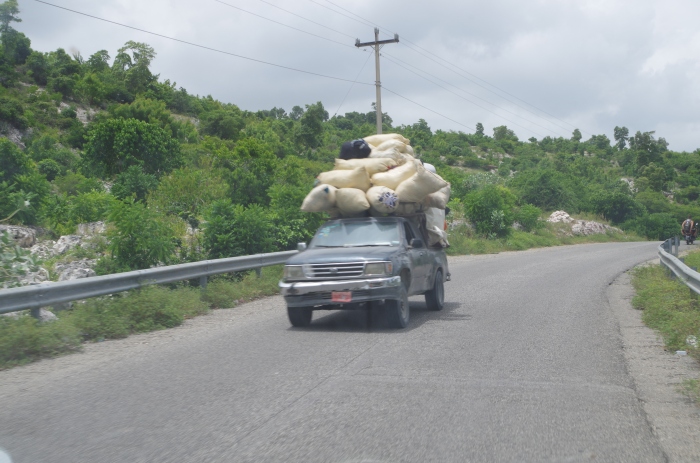
Arriving at this rural Haitian hospital, we soon learned that it was actually an outpatient hospital and therefore didn’t have many patients. At the time, this made some members of the team feel disappointed as they wanted to visit and show those patients that we care for and about them. Interestingly, the hospital visit we did the next day caused many of us to feel like some sort of sick tourists, as we wanted to wish well and chat but the language barrier prevented us from doing more than viewing the conditions and then departing the room.



The very first room we saw was indicative of the remainder of the hospital visit – a small cubbyhole of a room with “Laboratoire” (Laboratory) handwritten above it, we walked in to find a neatly painted but far from sterile area with a small table and a meagre handful of supplies needed to do blood testing and the like. As I have said before and will likely say again though: this is fully in line in doing the best they can with what they have.
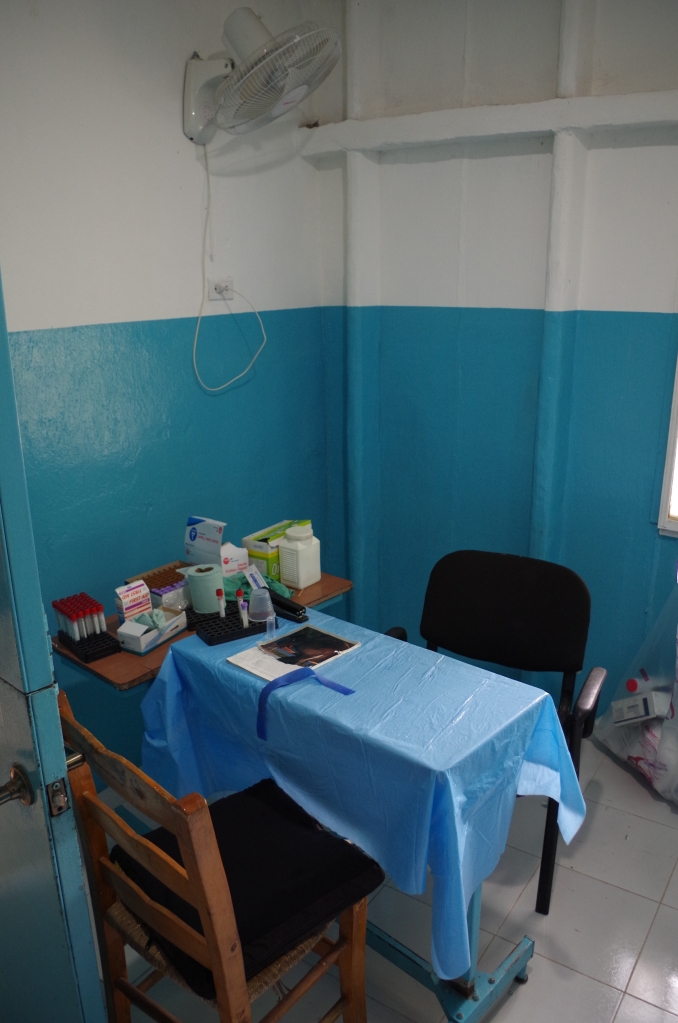

Far more staccato in both its concerning but hope-giving elements was finding the below 1950’s era X-ray machine. On the one hand, this means that broken bones and other diagnostic procedures are actually possible in an area where people don’t even have enough to eat… on the other hand, aside from the pair of protective lead vests in the corner, the room and door appears to feature zero (0) lead armor to protect the surrounding area from all the excess radiation given off in the process. On the whole, a net medical gain for the patients here… and bad news for staff consistently working around the X-ray room.

The main surgery room was in really good shape, although one can definitely see a mosaic of different time periods from which the different donated equipment here was brought in.
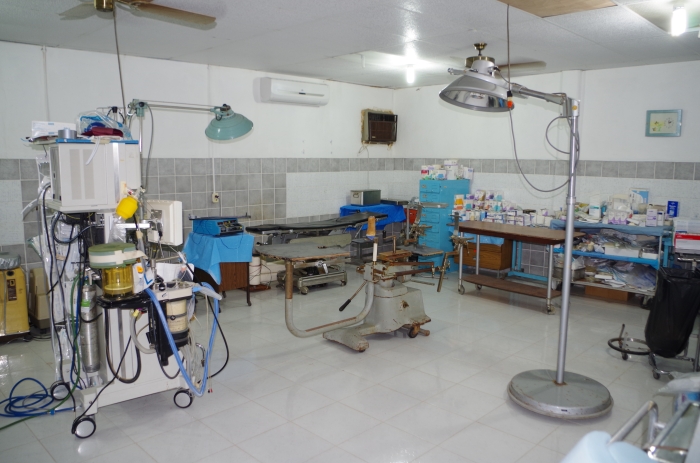
Another one of the portions of the visit which was very depressing but “best that can be done given the circumstances” was the sterilization station for the surgical implements. A hospital really ought to have and make consistent use of an autoclave, a tool which is able to quickly, efficiently, and thoroughly clean implements before they can (or ought to) be used on the next patient. Below you see a manual cleaning station, which means that 1) implements stay in the open air and thus accumulate dirt and worse over time; 2) the cleaning by hand means it will be unevenly cleaned at best; and therefore 3) at least some of the people who come in for one surgical procedure… will end up coming back for the follow-up amputation required to purge infections from their body.

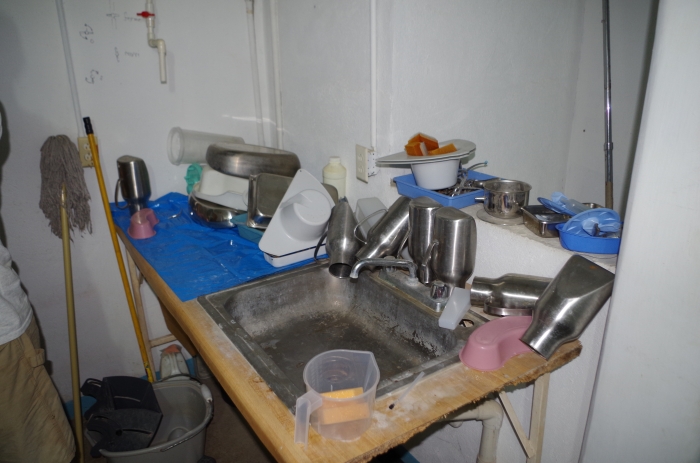
Walking outside again we were an odd combination of impressed with what had been built in this backwater rural hospital; but also saddened that so many amputations and infections could be prevented if it were just possible to get the donated goods to the outlying areas of Haiti (see here: rampant corruption in the capital as primary blocking factor).

Visiting a Cuban goodwill hospital (and its integral classroom for teaching Fidel’s Life Essentials™)
Our next trip took us to a Cuban goodwill hospital in the same relative area of Haiti.


This Cuban (and apparently Venezuelan) hospital was very well-kept and meant to be welcoming, with artwork on the front and a Haitian flag featured prominently between the flags of those who pay for this service.

The building may also be an outpatient hospital as there was NO ONE there aside from 2 seldom-seen Cuban staff members. This meant we got to see very closely the sort of conditions available to local Haitians – and everything we saw seemed to be very clean and well-kept, albeit not especially new.

Obligatory diesel Toyota truck with a snorkel. Need one of these, one day….

One day.
The top floor of the hospital building apparently moonlights as a cultural education center, with a classroom featuring all manner of educational/propaganda about the benefits of the Cuban way of doing things:
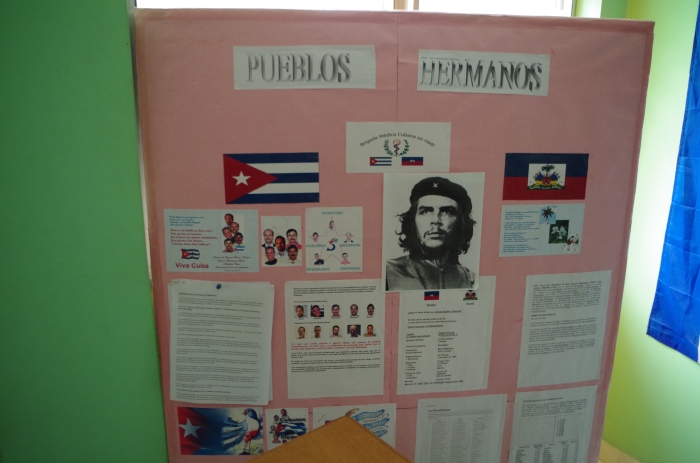

On the drive back, we saw a couple of the ultra-rich mansions on the side of the mountain, which really evoke a certain sort of “amidst the wilderness” that is lost in the hustle and bustle of typical Haitian town living. But to be sure: between pockets of towns and handfuls of houses, Haiti definitely has some areas of untamed nature.
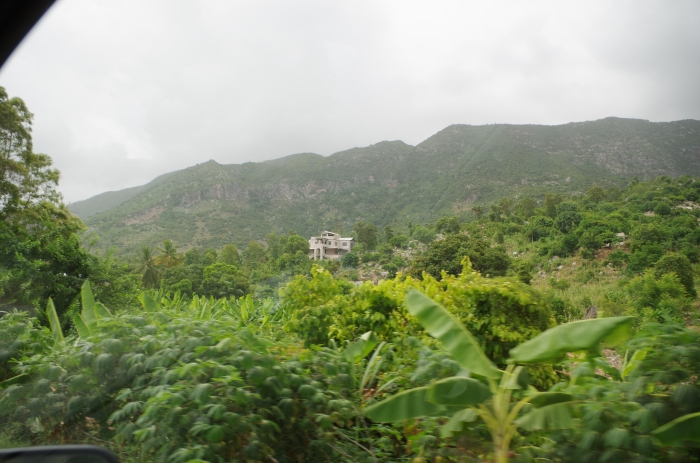
Of interesting note, especially at the tail end of a visit to a Cuban institution, was that I saw 2 openly-identified American institutional donations over the entirety of my time in Haiti – in both cases, including the below truck, I saw a reused USAID tarp. I am curious as to whether this means more US donations were food or other immediate-use items, or if Jacmel doesn’t feature much US-origin assistance.

Summarizing Day 2
As I commented on Facebook that day,
Day 2: my developing country Spidey senses are miscalibrated. “Wear a long sleeve collared shirt to really stay out of the sun, it is worth the extra bit of sweat” is genuinely valid advice in Zambia and the Middle East… turning out to be not as valid in 90%+ humidity Haiti.
Additionally, it is fun listening to Creole and picking up plenty of French or derivatives in between other incomprehensible words. Especially satisfying to speak some rusty French to folks here and watch their eyes go VERY wide at an American who can speak more than American English.
Looking back on that experience, I stand by that appraisal as my general summary for Day 2. It was a real pleasure to get to use some rusty French and be able to start a week-long process of making a HUGE difference for that local computer school; I also really enjoyed the visits we did to the rural hospitals and getting to see some excellent indications of the weird way in which most formal intergovernmental aid flows into Haiti and is either corrupted to the point of not reaching end users; or is not implemented entirely rightly. I don’t have a good enough handle on the general effect of individuals and groups providing aid into Haiti, but I believe our experience was a good case study (bolstered by my brother doing 4 back to back weeks): you need to know local Haitian people and work with them to create longer term programs to have anything succeed. Just giving items out might be a necessary stopgap in some cases, but doesn’t do anything to create lasting local improvement over time. In short, good intentions are FAR from sufficient to effect good outcomes.
That said: it was even more enjoyable to be a part of my brother’s efforts in Haiti, aimed at creating programs and classes for local folks over the long term.


Thank you Michael for your service and your keen observations. Haiti is a better place because of your visit
LikeLike